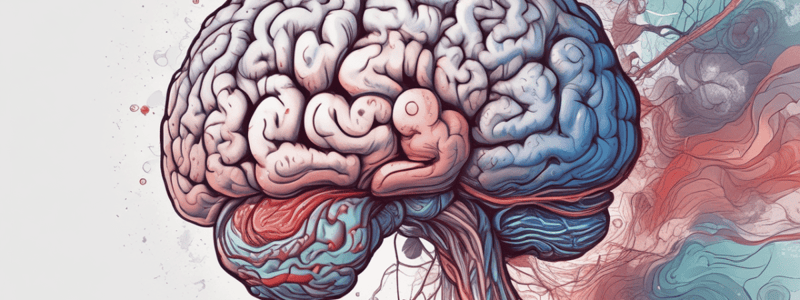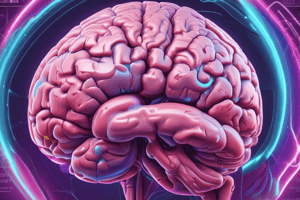Podcast
Questions and Answers
Which population is more frequently affected by brain abscess secondary to otitis media?
Which population is more frequently affected by brain abscess secondary to otitis media?
- Young adults
- Pediatric population (correct)
- Elderly
- Middle-aged adults
Which condition is more frequently associated with brain abscesses in young adults?
Which condition is more frequently associated with brain abscesses in young adults?
- Sinusitis (correct)
- Otitis media
- Tooth infections
- Meningitis
Which of the following groups is at higher risk for abscesses due to immunocompromised status?
Which of the following groups is at higher risk for abscesses due to immunocompromised status?
- Healthy adults
- Patients with sinusitis
- Patients with HIV (correct)
- Pediatric population
Solid organ transplant patients fall into which risk category for developing abscesses?
Solid organ transplant patients fall into which risk category for developing abscesses?
Most abscesses have which of the following characteristics?
Most abscesses have which of the following characteristics?
Which organisms are most commonly identified in postoperative brain abscesses?
Which organisms are most commonly identified in postoperative brain abscesses?
What location is most frequently associated with brain abscesses caused by otogenic infections?
What location is most frequently associated with brain abscesses caused by otogenic infections?
What is often indicated by the presence of multiple brain abscesses?
What is often indicated by the presence of multiple brain abscesses?
Sinus infections most commonly lead to brain abscesses in which area?
Sinus infections most commonly lead to brain abscesses in which area?
What percentage of brain abscess cases identify streptococci?
What percentage of brain abscess cases identify streptococci?
Which imaging technique is highly sensitive for detecting abscess?
Which imaging technique is highly sensitive for detecting abscess?
Which of the following findings on a CT scan might suggest the presence of an abscess?
Which of the following findings on a CT scan might suggest the presence of an abscess?
What directly contraindicates the use of LP in the diagnostic process described?
What directly contraindicates the use of LP in the diagnostic process described?
What is the rationale for using a CT scan in diagnosing abscesses?
What is the rationale for using a CT scan in diagnosing abscesses?
Why might an LP be considered inadvisable in the diagnostic process here?
Why might an LP be considered inadvisable in the diagnostic process here?
What is the typical onset speed of the illness described?
What is the typical onset speed of the illness described?
How common is fever among patients with this illness?
How common is fever among patients with this illness?
Which clinical feature is rarely observed in this illness?
Which clinical feature is rarely observed in this illness?
What is typically revealed during a detailed physical examination?
What is typically revealed during a detailed physical examination?
What is often accompanied by focal deficits in patients with this illness?
What is often accompanied by focal deficits in patients with this illness?
Which type of antibiotic should be added if the patient is recently postoperative?
Which type of antibiotic should be added if the patient is recently postoperative?
When selecting antibiotics for treatment, which factor is considered most crucial?
When selecting antibiotics for treatment, which factor is considered most crucial?
Which combination of antibiotics is recommended as part of the initial treatment?
Which combination of antibiotics is recommended as part of the initial treatment?
What is a standard consult to consider when treating with antibiotics in the context provided?
What is a standard consult to consider when treating with antibiotics in the context provided?
Why is Vancomycin added to the antibiotic regimen for postoperative patients?
Why is Vancomycin added to the antibiotic regimen for postoperative patients?
What route accounts for one third of cases where organisms reach the brain?
What route accounts for one third of cases where organisms reach the brain?
Which route describes organisms reaching the brain through direct transfer due to a surgical procedure?
Which route describes organisms reaching the brain through direct transfer due to a surgical procedure?
Which of the following statements is true regarding the pathophysiology of organisms reaching the brain?
Which of the following statements is true regarding the pathophysiology of organisms reaching the brain?
Which of these routes is known to occur in about 10% of cases of brain infections?
Which of these routes is known to occur in about 10% of cases of brain infections?
Which route is not specified in the pathophysiology content provided?
Which route is not specified in the pathophysiology content provided?
Flashcards are hidden until you start studying
Study Notes
Risk Factors
- Brain abscesses are more common in pediatric population when related to otitis media.
- Young adults are more likely to develop brain abscesses associated with sinusitis.
- Immunocompromised patients, such as those with HIV or solid organ transplant, are at higher risk.
Pathophysiology
- Organisms can reach the brain through hematogenous spread (1/3 of cases), contiguous infection from nearby structures, or direct implantation during surgery or trauma (10%).
- The route of infection is unknown in the remaining cases.
Brain Abscesses
- Streptococci are found in up to 50% of cases.
- Otogenic infections often involve bacteroides and occur in temporal lobes or cerebellum.
- Sinus infections lead to brain abscesses in frontal areas.
- Postoperative brain abscesses are often caused by S.aureus and P.acnes.
- Multiple abscesses suggest hematogenous spread, often from endocarditic, intravenous drug abuse, or pulmonary etiologies.
Clinical Features
- Brain abscesses have a subacute onset and patients are rarely toxic appearing.
- Symptoms may progress over a week or more.
- Fever is present in fewer than half of cases, and nuchal rigidity is also rare.
- Focal deficits and papilledema are often present on physical examination.
Diagnosis
- CT scans show hypodense lesions with contrast enhancing rings.
- MRI is highly sensitive for abscess and demonstrates similar findings to CT scans.
- LP is contraindicated.
Treatment
- Appropriate antibiotics and neurosurgical consultation are necessary.
- Antibiotic choice should consider likely pathogens and CSF penetration.
- A third-generation cephalosporin and Metronidazole are often used.
- Vancomycin may be added if the patient is recently postoperative.
Studying That Suits You
Use AI to generate personalized quizzes and flashcards to suit your learning preferences.




